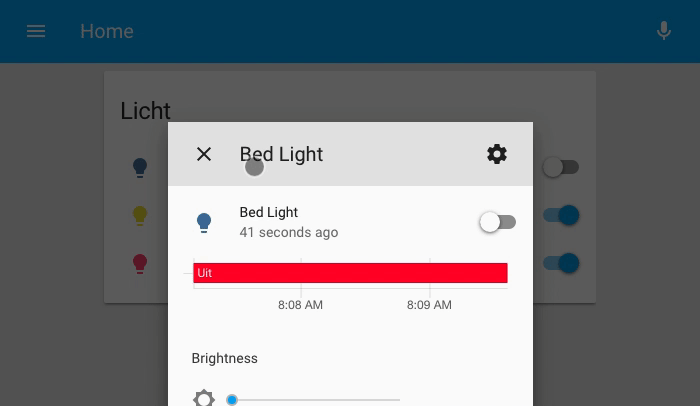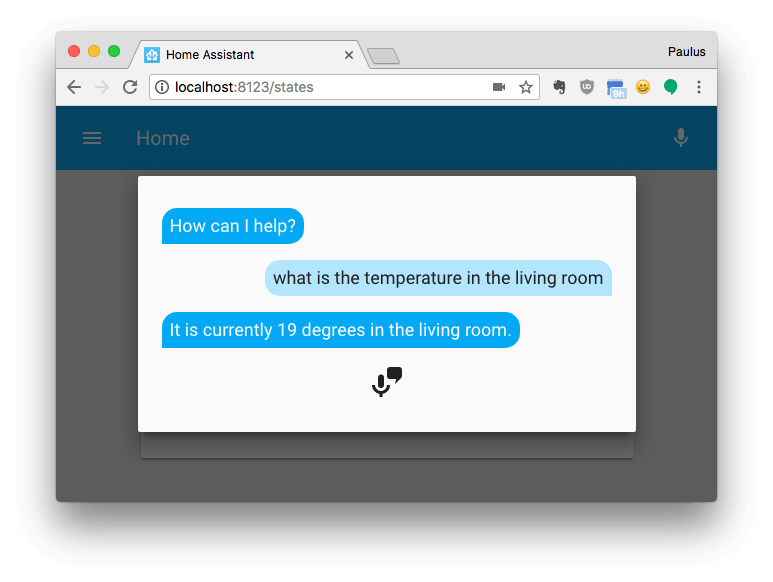Release 0.65 has arrived and oh boy, is it awesome. First off, in case you have missed the previous release notes and announcements: Starting with this release, Home Assistant has dropped support for Python 3.4. The minimum supported version is now Python 3.5.3. If you are on Hass.io or Docker, you’ll automatically be running the latest and greatest. If you’re on an older Hassbian installation or did your own Linux setup you’ll need to upgrade to at least Python 3.5.3.
Naming entities
With the introduction of the entity registry in 0.63, Home Assistant is making sure that the same devices always receive the same entity IDs. This release is taking it a step further by allowing users to change the name of a device from the frontend. Changing the name will be instantly applied and overrides whatever name the device is given by the integration. If you want to switch back to the name from the integration, set the name to blank.
This feature is, just like the entity registry, only available for integrations that provide unique IDs for their entities. Adding this to each integration is still a work in progress.
 The new entity registry settings page in action.
The new entity registry settings page in action.
Filter sensor
The filter sensor is a new 2nd order sensor by @dgomes: it will consume data from a sensor entity and apply filters to it. For the initial implementation it comes with Low-pass, Outlier and Throttle filters. Expect more to be added in the future.
sensor:
- platform: filter
name: "filtered realistic humidity"
entity_id: sensor.realistic_humidity
filters:
- filter: outlier
window_size: 4
radius: 4.0
- filter: lowpass
time_constant: 10
precision: 2
 Graph showing both the input sensor and the output of the filter sensor.
Graph showing both the input sensor and the output of the filter sensor.
Light Group
We have had some discussion lately and realized that our current group component is very limiting. Extending it would probably lead to more confusion so we’ve decided to take a new approach: groups that are designed to be part of a specific component. The first one in this series comes at the hand of @OttoWinter: the group light (docs).
The group light creates a single light inside Home Assistant that is representing a group of lights. All commands will be forwarded and the state is a combination of all the lights.
light:
- platform: group
name: Cool Light Group
entities:
- light.amazing_light
- light.foobar
- light.sun
HomeKit
HomeKit got some more upgrades. We’ve added support for temperature sensors in Fahrenheit, alarm systems, switches and thermostats. Just a few releases more and we should be able to cover it all.
Optional words for the Conversation component
The conversation component has always been a great introduction to controlling your house by voice. There is no hotword detection or powerful language engine behind it, but it gives a great intro to what is possible. Starting with this release, it will get a little bit more powerful with the introduction of optional words. To mark a word optional, wrap it in square brackets: Change the light to [the color] {color}.
# Example configuration.yaml entry
conversation:
intents:
LivingRoomTemperature:
- What is the temperature in the living room
- What is [the] living room temperature
intent_script:
LivingRoomTemperature:
speech:
text: It is currently degrees in the living room.
 Have conversations with Home Assistant via the conversation component.
Have conversations with Home Assistant via the conversation component.
New Platforms
- Synology Chat as a notification platform (@cmsimike - #12596) (notify.synology_chat docs) (new-platform)
- KNX Component: Scene support and expose sensor values (@Julius2342 - #11978) (knx docs) (scene docs) (binary_sensor.knx docs) (new-platform)
- Adds simulated sensor (@robmarkcole - #12539) (sensor.simulated docs) (new-platform)
- Add Songpal (“Sony Audio Control API”) platform (@rytilahti - #12143) (media_player.songpal docs) (new-platform)
- Add UpCloud platform (@scop - #12011) (upcloud docs) (binary_sensor.upcloud docs) (switch.upcloud docs) (new-platform)
- Added Sense energy monitor sensor (@kbickar - #11580) (sensor.sense docs) (new-platform)
- Filter Sensor (@dgomes - #12650) (sensor.filter docs) (new-platform)
- Add light.group platform (@OttoWinter - #12229) (light.group docs) (new-platform)
- Egardia redesign - generic component and sensor support (@jeroenterheerdt - #11994) (egardia docs) (alarm_control_panel.egardia docs) (binary_sensor.egardia docs) (breaking change) (new-platform)
- Add support for Zillow Zestimate sensor (@jcconnell - #12597) (sensor.zestimate docs) (new-platform)
- Add a Media Player Component for Channels (@maddox - #12937) (media_player.channels docs) (new-platform)
- Add support for alarm system, switch and thermostat to homekit (@maxclaey - #12819) (homekit docs) (new-platform)
- Add camera proxy (@PhracturedBlue - #12006) (camera.proxy docs) (new-platform)
Release 0.65.1 - March 10
- allow ios device tracker see calls to go through (@balloob - #13020) (device_tracker docs)
- Fix config component loading YAML (@kellerza - #13024)
- Make Throttle async aware (@balloob - #13027)
- Add support for input boolean to Google Assistant (@balloob - #13030) (google_assistant docs)
- HomeKit Bugfix: names (@cdce8p - #13031) (homekit docs)
Release 0.65.2 - March 10
- Fix translations sometimes not loading in the frontend (@armills)
- Fix sensibo’s min/max_temp properties (@jra3 - #12996) (climate.sensibo docs)
- Use request.query (@ptarjan - #13037) (wink docs)
- Ensure we have valid config AFTER merging packages #13015 (@kellerza - #13038)
- Bump pysabnzbd version (@jeradM - #13042) (sensor.sabnzbd docs)
- Fix async lifx_set_state (@amelchio - #13045) (light.lifx docs)
- Yeelight version bumped. (@syssi - #13056) (light.yeelight docs)
- Don’t call async from sync (@balloob - #13057) (xiaomi_aqara docs)
- Convert decimals from SQL results (@balloob - #13059) (sensor.sql docs)
Release 0.65.3 - March 11
- Implement Hue available property (@balloob - #12939) (light.hue docs)
- Catch async from sync context by running asyncio event loop in debug mode during tests (@balloob - #13058) (camera.arlo docs) (climate.generic_thermostat docs)
- Fixes KNX fire event problem, issue https://github.com/home-assistant/home-assistant/issues/13049 (@Julius2342 - #13062) (knx docs)
- Bump iGlo Version (@jesserockz - #13063) (light.iglo docs)
- Fix Tado doing async wrong (@balloob - #13078) (device_tracker.tado docs)
- Synology Camera: auto-renew session when it’s expired (@snjoetw - #13079) (camera.synology docs)
- Revert “Cast automatically drop connection (#12635)” (@OttoWinter - #13094) (media_player.cast docs)
- Bump pyvera to 0.2.42. Improve event loop robustness. (@pavoni - #13095) (vera docs)
- Fix Kodi by updateding jsonrpc-websocket to 0.6 (@Tadly - #13096) (media_player.kodi docs)
If you need help…
…don’t hesitate to use our very active forums or join us for a little chat. The release notes have comments enabled but it’s preferred if you use the former communication channels. Thanks.
Reporting Issues
Experiencing issues introduced by this release? Please report them in our issue tracker. Make sure to fill in all fields of the issue template.
Read on →



